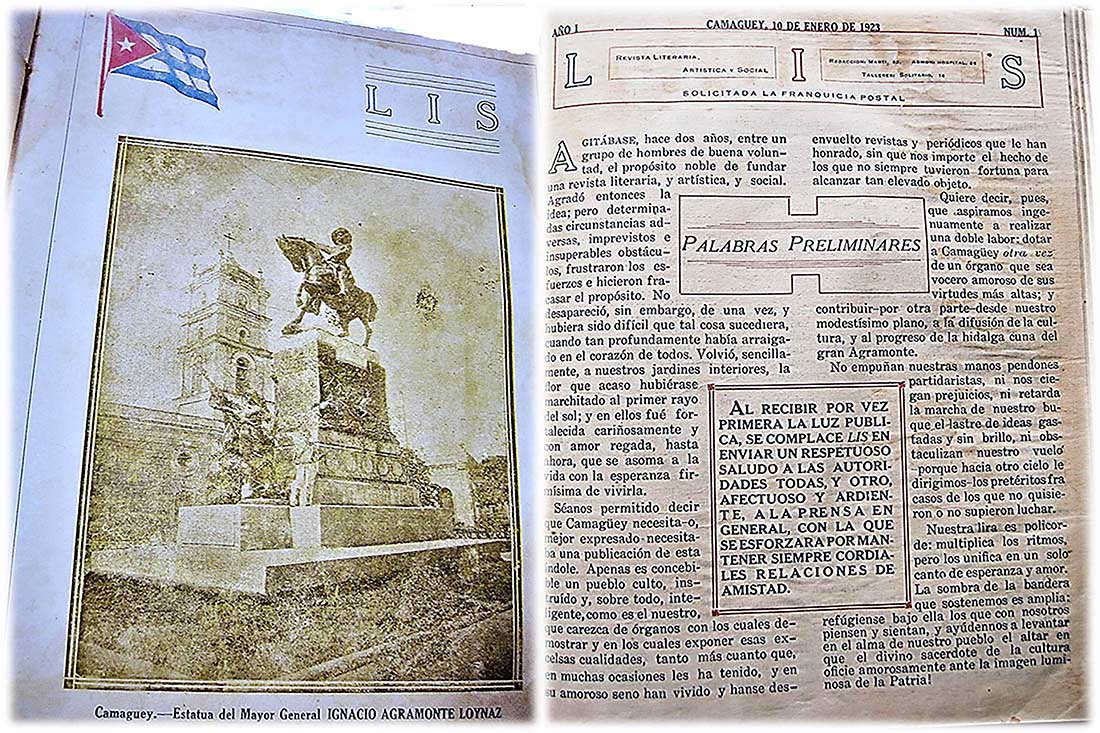The LIS Magazine was created in a familiar context during the first years of the second decade of the twentieth century for an educated, knowledgeable and above all intelligent people like ours, message of the initial leaflet under the title “Preliminary Words”. Nicolás Guillén Batista, his founder, distinguished his family to crystallize this cultural proposal. Understand family, as that small system of interpersonal, intimate and affective relationship that transcends blood ties. Capable of encompassing a network of relationships much broader than those limited to the home space.
What was LIS and who came together around it?
This magazine was published from January 10th, 1923 to June 30th of the same year, with 18 issues in total. Among its purposes, the magazine indicates to provide Camagüey with a news media that would be a loving spokesperson for its highest virtues; and contribute, on the other hand, to the dissemination of culture and the progress of the nobility cradle of the great Agramonte.
It kept its format and its status as an artistic, literary and social magazine until its last issue. The first page was always composed of a cover whose appearance varied in each issue and on its reverse; it included a directory of professionals and transcendent trades of the town almost entirely practiced by blacks and mestizos. Doctors, lawyers, medical midwives, public attorneys, legal representatives, among others, with their private addresses and hours.
This publication became part of the extended family of the Victoria Association, as Nicolás, as well as Francisco, his brother and deputy director of the magazine, were closely linked to it. Félix Napoles, the magazine’s editor-in-chief, at that time was Victoria’s vice secretary of correspondence and he was the one who typewritten all of Guillén’s lines up to then, grouped together in two handwritten school notebooks. Consequently, Pedro T. Cebrián, the magazine’s administrator, was precisely the elected vice president of the aforementioned association. Certainly the evidence points to a family coincidence between the directors of the LIS Magazine and the Victoria Association.
Purposes of LIS
The magazine had two well-defined visions, although it was open to the Hispanic-American and universal thought of the time, it also made the national culture known from the locality, its main mission. In this sense, the following can be distinguished, for example, in the sections of poetry, short stories and articles: writers from the courtyard, some still unnoticed, such as Tomás Vélez Vázquez, Francisco Guillén, José Armando Plá, Félix Napoles, Guillermo Cisneros Zayas, Edmundo del Vals, Antonio Márquez, José Varona Hernández, Josefa Guillén, Aurelia del Castillo de González, Nicolás Guillén (these last two authors transcend the locality, the first of national relevance and the second international).
Likewise, the verses of José Martí, Gabriel de la Concepción Valdés (Plácido), Juan Clemente Zenea, Julián del Casal, Rubén Darío, Amado Nervo, the prose of José Enrique Rodó, Guy de Maupassant, among others, are signified from universality.
Systematized themes
The magazine LIS committed to national freedoms made visible the glorious past of the wars of independence, through letters from personalities and portraits. In that order are the letter from the Great Citizen, Salvador Cisneros Betancourt to Benjamín Guerra and Gonzalo de Quesada, informing him of the new beginning of Camagüey in the wars of independence; that of Major General Antonio Maceo to Flor Crombet, specifying his absolute opposition to any act of treason against the Spanish General Arsenio Martínez Campos, what integrity!
Weighted educational and artistic profiles
Academic achievements were commended from the graduations and progress reviews of the sons of these associates. The private academies such as the Vélez Academy, where Nicolás studied, were distinguished. The Academy of Graciliano Garay: Complete education of the Baccalaureate, the Polytechnic Academy, among others.
The musical promotion distinguished the development of different talents such as the accredited “Camagüey Jazz Band” orchestra, exhibitor of various formats and genres, among other recognized masters orchestras, small groups.
The presence of popular culture in context is noted, there is the San Juan Camagüeyano within the aforementioned associations, its different expressions in competitions, dances, comparsas, floats, queens, also the religious festivities in houses of distinguished families of the locality, among other cultural practices.
Transcendence
LIS paid tribute to the Cuban literary map. It revealed a local thought interconnected with the nation and the world.
Bibliography
Guillén, Nicolás (1923) Revista Lis, s/e, 18 números.
Henry Knight, Kezia Zabrina ((2017) “Nicolás Guillén y la revista Lis, una ofrenda familiar”. Revolución y cultura, (1) enero-febrero-marzo, pp. 64- 67. ISSN 0864-1315 Índex: http://www.google.com/docplayer.es/amp/77877624
Translated by: Aileen Álvarez García






